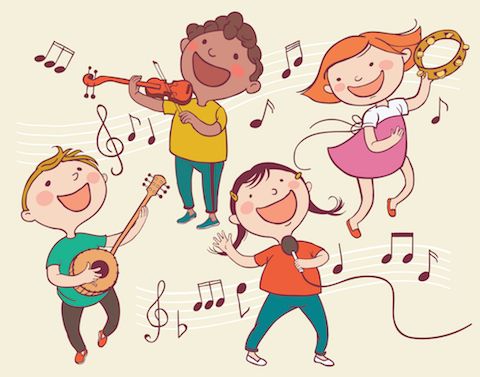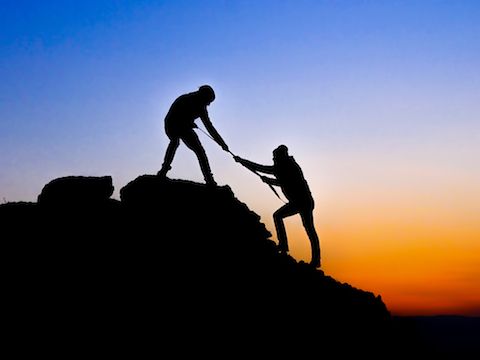
I came across an intriguing article by Amy Burns the other day called Thinking Outside the Music Box: Using Digital Tools to Teach Music. Immediately I could tell that she was an enthusiastic and energetic teacher, even after 20 years of teaching at Far Hills Country Day School in New Jersey. After having the opportunity to sit down and interview Amy, the answer to her strong drive became clear - it lies in her steadfast commitment to her learners and a forward-thinking embrace of music technology.
Burns realizes the importance of music education in the development of children's brains and the correlation it has to deeper critical thinking. Technology can enhance the teaching process and reveal complex avenues of learning that on the surface do not appear.
One avenue of learning is musical composition. Burns has seen a tremendous increase in musical understanding through collaborative software tools that lead to complex musical creations. Seven-year-olds are developing melody lines that become vastly layered, multi-instrumental professionally sounding songs. A Cloud-based recording studio makes collaboration easy between users and encourages ambitious students to continue classroom assignments at home.
In my interview below, Burns paints a fascinating picture of her whole learner environment. The classroom is filled with singing, dancing, performing, instrument playing, and complex music composition; every student marching to the beat of their own drum. Technology is Amy Burns' best friend, colleague, and production department - all wrapped into one. It's an infectiously happy learning environment steered at the helm by a remarkable educator.
Interview
Rod Berger: Amy, I appreciate your time today. The energy was coming through so I'm looking forward to this conversation.
We were talking off-air about the arts and technology and what you were using with younger students. Let's talk a little bit about your background and how your path using technology has impacted the way in which you interact with young students.
Amy Burns: I started teaching general music at this school 20 years ago and I've been a music teacher for 21 years. Most of my career has been at Far Hills Country Day School. I love this school. It's an independent school in New Jersey. It’s Pre-K through eighth grade and it supports the arts beautifully.
I graduated with my bachelor’s degree from Ithaca College in New York. At that time in the mid-nineties, we didn't have to actually learn any technology.
So when I got to Far Hills, they replaced one of the music rooms with a music lab; and I had to start figuring out how to use technology.
There was an organization called Technology Institute for Music Educators and “TI:ME” is their acronym. They had these classes that taught you how to integrate technology into music.
I took one and realized, “Wow, there are more ways I can reach my district. What a great tool!”
I never really used the music lab because it was in the older students’ music room, but I did start to integrate technology because I found it to be another way to reach all the students in my classroom.

I'm an elementary general music teacher. They sing and I sing with them. We dance. We move. We play instruments. We do everything in our music classroom.
And technology is just another wonderful tool to use to help reach all my students.
When it comes to composition, technology is a really wonderful tool for them.
My capstone research project for my graduate degree was students traditionally composing in second grade with paper, pencil, and staff paper and using technology. And we’re using that in a way that they could also learn their musical concepts.
The second graders using technology really could grasp their musical concepts so much better because the technology was so successful for them. They didn't struggle as much. They're used to technology.
You know. You have two children. I have two children ages 7 and 5. My five-year-old goes through the world without an iPad. She's always grown up with one.
For them to click and drag notes, they still need to know the basic musical and foundational skills. But it's much more successful for them to compose.
Even some of my students who have fine motor skills, they struggle and they have concerns. A virtual instrument connected to a speaker works so successfully for them as opposed to trying to hold mallets to an Orff instrument.
Or recorders ─ there is a way I can use an app to be a virtual recorder for some of my students. It's not the easiest thing to use but they do use it well.
I just love the way technology is a great tool that can help students do things that they traditionally probably couldn't do about 20 years ago - such as composition and some of these instruments that aren’t always successful for students who struggle with fine motor skills.
RB: Amy, what about the variety of instruments when you're talking about the virtual experience? I would imagine that it opens up an entirely new and bigger world because you're not just focused on the physical instrument where you can only have so many.

When you have a virtual world, one that is really thoughtfully put together; your kids can be playing and interfacing with instruments that I would imagine they normally do not access.
AB: Yes, especially when we're celebrating the Chinese New Year because the students study Mandarin at our school. I love to have them experience the Chinese instruments. We go on YouTube and watch very skilled players - beautiful musicians.
They don't get to try these instruments and I don't have access to them. But using virtual instrument apps ─ GarageBand has pipa and erhu; and other apps have Chinese drums, the students get to actually experience it.
My kindergarteners have created and recorded a Chinese New Year song using a virtual erhu and then loops from a virtual pipa. They actually created it.
You can see it on my website. I have pictures up there showing the students playing the app. They're actually moving their hands back and forth on the erhu to hear the different sounds.
It's phenomenal to see how musical they made this song because they were just listening to this erhu performed and playing it on the iPad. It was quite cool and it was one iPad and a class of 15 kindergarteners. It was a wonderful thing that we could share right in their digital portfolios. The parents got to experience it at the end of day. It was something that made us very proud.
RB: How has Soundtrap impacted your students in the way they've interfaced together at home and with you in class?
AB: Soundtrap has been wonderful. One of the struggles we were having a few years back is that my students and I love to compose, share and collaborate but GargeBand had limitations.
GarageBand was very user friendly and very intuitive for my young students, but you couldn’t collaborate, so the compositions were stuck in my classroom and stuck on my laptops and iPads. If it froze in the middle of their creation, it was gone; and things like that would happen on occasion.
I ran into Soundtrap when I was teaching a graduate class in 2015 at Central Connecticut State University and someone wrote a blog post about Soundtrap that it's like GarageBand plus Google Docs. He called it the “love child” of GarageBand. I loved this author’s post. (laugh)
So it was like, wow, that is cool!
I had the class try it out with me and it was fabulous. We can collaborate across the room.
It's truly phenomenal. I got the EDU version because it is free. You can try it out.
So I tried the free version and I had the class of music teachers try out the free version. We loved everything about it.
And then, I said, “I've got to get the EDU.” The EDU is in my classroom. The IT in my school helped create an account because my school graders used it this year.
The students don't have email addresses, so IT created accounts for each device in my classroom and the kids can collaborate with each other in the classroom. They would work together in small groups and then, they share their piece with the group over there.

It was phenomenal and we just had the best time collaborating and working together. It's very intuitive for any age group. I used it with second grade and up. They created a four-measure melody and then exported it and put it right into Soundtrap and gave them a style. We talked about styles.
It was really wonderful for them because they had to listen to make sure that their melody didn't get covered up. They had to understand the style when I gave them rock as opposed to electronic dance music.
They loved it. They were asking questions about the difference. They were hearing the difference.
Then they worked together to make sure that when they created the different melodies that they created an intro and outro.
This is second grade; we're talking about seven-year-olds.
My daughter who is running outside right now there singing something (laugh), she worked with a group and did this. They were very proud of their compositions.
They had to understand that they couldn't have dueling drummers. I said, “Do you look at a band and see two drummers in the back of the band?”
Normally, no, you don't.
They couldn't have all these dueling musicians so they had to start listening and making sure they had the correct instrumentation for their style.
It was really wonderful.
When they finished, they presented it to the class. They talked about what they liked, what they wished it could have been, and they wondered, “I like my style but I wish I had more time. I wonder what it would have sounded like if I had added a b section.”
It was really fabulous for them to reflect on the experience.
That particular project I put up on “Seesaw” pages, this morning, it’s their digital portfolio system, and the parents received it today.
Soundtrap makes it so wonderfully intuitive for children. It gives second graders, and seven-year-olds the ability to create music and own it.
They have to have foundational skills; the students have had me since Pre-K, so they have foundational skills.
When I test them, eighty-five percent of the students have the foundational skills to compose this way.

When I group them, the fifteen percent that are struggling work with those who have the foundational skills, and they get them working, composing and creating.
RB: Let's close with this, Amy. I would imagine that confidence is a big player when it comes to collaboration. When I think about my experiences or those of my friends and colleagues when growing up, if you didn't feel you were very good at something, you might not want to participate.
But being in an environment where you can collaborate and it's not failure; you try different things out; you understand the layers, like not having dueling drummers for example. It expands the audience even at the youngest levels of potential future musicians or just kids who feel good about themselves within music.
Am I wrong in that?
AB: No. They all take ownership and they all feel good about it. They have things they want to improve on, the “I wish, I wonder?”
Definitely! But that's all part of the process.
What I also love is they have pianists inside the program. Students compose their four-measure melody, put it into Soundtrap and begin to realize where they can take it. The students are more prone to go home, go to their piano, and compose even more. It started to open doors for students that they didn't quite know were there.
It was another thing that I adored about these students. They were seeing you don't just stop at a composition. Look at how much further you can take it and you have the ability to take it very far at this age.
RB: Your energy is infectious. I'm sure the audience can see that as well. And you are a door opener for your students and they're lucky to have you.
Thank you so much, Amy.

About Amy M. Burns:
Amy M. Burns has been teaching general music to grades pre-kindergarten through four, directing the Far Hills Philharmonic for grades four through eight, co-directing the elementary chorus and Broadway Jr enrichment groups, and coordinating The Far Hills Conservatory at Far Hills Country Day School in Far Hills, NJ, for the past twenty years. A widely known music educator, author, and clinician on how to effectively integrate technology into the elementary music classroom, she credits her colleagues, administration, and the members of the Technology for Music Education (TI:ME) organization and NJMEA for her success in teaching music to elementary students.
Amy holds a Bachelor of Music in both Education and Performance from Ithaca College and a Master of Science in Music Education from Central Connecticut State University (CCSU), with her capstone research project focusing on composition with music technology at the second grade level. She also holds TI:ME levels 1 and 2 certifications. In 2005, Amy received the first-ever TI:ME Teacher of the Year Award for her innovative uses of technology in the elementary music classroom. In 2016, Amy received the NJMEA Master Music Teacher Award and the Governor's Leadership in Arts Education Award.
She is the lead author and editor of a book of technology-enhanced lesson plans titled, Technology Integration in the Elementary Music Classroom, published by Hal Leonard and is currently a contributing author to Online Learning Exchange™ Interactive Music powered by Silver Burdett. She recently began writing a Help Series of ebooks, which the first two resources are titled Help! I am an Elementary Music Teacher with a SMART Board! and Help! I am an Elementary Music Teacher with One ore more iPads!
Further Reading:
MyCentralJersey.com - Far Hills educator selected as master music teacher
NAIS Magazine - How to Connect Elementary General Music across the Curriculum
Additional Reading:
How EdTech is changing teaching in the classroom
Thought leaders bringing professional music composition to schools
Education technology that supports STEAM programs
About Rod Berger, PsyD.
Dr. Rod Berger is President and CEO of MindRocket Media Group. Berger is a global education media personality and strategic influencer featured in The Huffington Post, Scholastic, AmericanEdTV, edCircuit, EdTechReview India and Forbes
Audiences have enjoyed education interviews with the likes of Sir Ken Robinson, Arne Duncan, Randi Weingarten, Sal Khan along with leading edtech investors, award-winning educators, and state and federal education leaders. Berger’s latest project boasts a collaboration with AmericanEdTV and CBS’s Jack Ford.
Follow Dr. Rod Berger on Twitter
